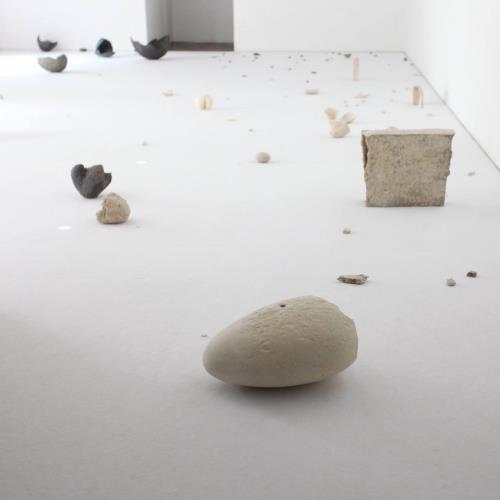Japan-based writer and traveller, specialising in design, lifestyle and travel journalism. Ron previously served as an editor of MING Magazine, ELLE Decoration and CREAM.

Photo provided by Gallery Yamahon
My friend proposed going to Tajimi of Gifu-ken. What kind of city is Tajimi? I got to know after query that it is the city where Mino Yaki is maufactured. “Is that the purpose of going to Tajimi is to look for Mino Yaki?” I asked my friend. “No. I would like to go to Tajimi for the purpose of visiting Baicao Art Gallery,” my friend answered. There was only one route on that day. Although we would travel to the city from Kyoto which is thousands of miles away, the only journey would undoubtedly make me believe that it is worthy. My friend supplementarily said: “Anyway, there is nobody isn’t deliberately travelling to Tajimi from thousands of miles away.”
Baicao Art Gallery is at a distance of fifty-minute ride to the nearest Tajimi railway station and of course nobody would come to Tajimi on the way. Baicao Art Gallery was founded by the ceramist Ando Masanobu in 1998. At that time, there was no living art gallery specialised in selling utensils fabricated by artists that can be found easily in Japan today. As a matter of fact, Baicao is the pioneer of such kind of art galleries: perosnal exhibitions were held for artists fabricating cups and disks, artist statements were released and forums were conducted. Many people in the circle believed that Baicao has significant influence on Japan’s art development and enabled artists to get close to citizens and bring arts to their life.
During the period in which no special theme exhibition was held, works by Ando Masanobu and his wife Ando Akiko were placed in Baicao. Clothes made by Ando Akiko were placed on the first floor, utensils fabricated by Ando Masanobu were mainly placed on the second floor and his several sculptures were placed at the eye-catching positions. The works of the botanic sculptor Iwatani Yukiko and gold craftman Kanamori Masaki were also placed in Baicao Art Gallery. Such arrangement cannot be taken all by eyes but still attracted great attention.
The building for Baicao Art Gallery is a Japanese ancient civilian house. Initially I thought that it was very lucky that Ando Masanobu found such splendid but elegant building on the mountain and afterwards I got to know that the building was bought from Nogoya. The original building was decomposed and then transported to the mountain in Tajimi. The garden is also very beautiful, filled with green and vital moss resulted from staffs’ careful removal of grosses every morning. The stone wall behind the garden seemed to be built by farmers over one hundred years ago but it was actually built along with the foundation of Baicao. It is not difficult to make it eye-catching but it is uneasy to make it beautiful and coordinated in the environment and such stone wall is to the point. After seeing the exhibition and garden, we came back to the indoor café, had cakes and took a short break and our journey was substantially satisfactory.
Hong Kong people usually said that there are three major factors for opening a store: Location, Location and Location. But it is strange that many art galleries in remote locations were the destinations of people taking a travel on the weekend although few people came to them on regular days and so operation was substantially good. Baicao is one of these galleries and another is Gallery Yamahon located in Iga of Mie-ken. If you want to go to Baicao but still do not want to take a taxi, it will be fine to keep on walking but this will not be feasible for going to Gallery Yamahon. A round trip to Gallery Yamahon will take at least four hours. Because it can be only reached by driving a car, it became the important destination of adjacent residents taking a trip and people in other regions also travelled there purposely. The difference between Gallery Yamahon and other living art galleries is that the gallery owner Yamamoto Tadaomi assigned most space to exhibit sculptures. Based on current conditions in Japan, generally relatively cheap utensils are well sold and sculptures always receive good evaluation but are sold badly, so most of the art galleries do not want to pay great efforts to such sculpture products. However, Yamamoto Tadaomi insisted on sculpture works for no reason. It’s almost 20 years since Gallery Yamahon was founded. It was heard that Gallery Yamahon showed a turn from loss to profit over recent years. Before this, Yamamoto Tadaomi had been operating the art gallery with revenue from his own architecture firm.
The art gallery of Gallery Yamahon is connected with the store. The sculpture works of arts holding personal exhibitions were placed in the art gallery, while practical and cheap utensils were placed in the store for selling. In addition, works of artists cooperating with Gallery Yamahon can be also found on the shelves. When I went for the exhibitions of Yoshitomo Nara and Yayoi Kusama, I can only take pencils, post cards or other prints, but after going to the exhibitions in Gallery Yamahon I can even take exhibitor’s works as souvenir and our journey also became more satisfactory. After careful thinking, I concluded that easy access has never been an important factor that artists considered in opening a gallery or art museum. Miho Art Museum and Teshima Art Museum are in a remote location and they can be only reached by long travel. However, the location where they are, local conditions and customs sublimated their charm. Baicao Art Gallery and Gallery Yamahon, which are interesting galleries, are more attractive due to geographical factor and have become the art enthusiasts’ travel destination.